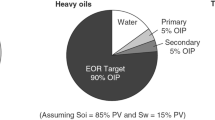By using the independently developed ultrasound generator, natural cores with different permeability are selected to carry out the indoor core displacement experiment under simulation of the temperature and pressure of the actual formation, and the effect of ultrasonic action on the removal of reservoir water sensitive damage has been evaluated during seepage. The results show that for removing reservoir water sensitivity, ultrasonic frequency has an optimal range, there is a certain compensation relationship between frequency and power, and there is a certain relationship between the optimal processing time of ultrasound and the physical properties of the reservoir. The relationship between permeability recovery rate and the physical properties of reservoirs presents a complex relationship. The results are helpful to understand the mechanism of ultrasonic water sensitive removal and provide theoretical guidance for the popularization of this technology in oil field.





Similar content being viewed by others
References
Zhenjun Wang, Jiehao Huang.research on removing reservoir core water sensitivity using the method of ultrasoundchemical agent for enhanced oil recovery [J]. Ultrasonics Sonochemistry,2018,42:754–758.
Nasir Khan, Chunsheng Pu , Xu Li, Yanlong He, Lei Zhang, Cheng Jing. permeability recovery of damaged water sensitive core using ultrasonic waves [J]. Ultrasonics Sonochemistry ,2017,38:381–389.
Khosrow Naderi, Tayfun Babadagli.Influence of intensity and frequency of ultrasonic waves on capillary interaction and oil recovery from different rock types [J]. Ultrasonics Sonochemistry,2010,17:500–508.
Kyllonen, H., Pirkonen, P., Mystrom, M.Membrane filtration enhanced by ultrasound:a review [J]. Desalination 2005,181: 319–335.
L.A. George, M.M. Dewoolkar, D. Znidarcic. Simultaneous laboratory measurement of acoustic and hydraulic properties of unsaturated soils [J]. Vadose Zone Journal ,2009,8:633–642.
Z. Lu, J.M. Sabatier, Effects of soil water potential and moisture content on sound speed [J]. Soil Science Society of America Journal,2009,73:1614–1625.
S. Griffiths, A. Rescaglio, F. Melo, Ultrasound propagation in wet and airless non-consolidated granular materials [J]. Ultrasonics ,2010,50:139–144.
Chunwei Shi a,b, Wei Yang a, Jianbin Chen.application and mechanism of ultrasonic static mixer in heavy oil viscosity reduction [J].Ultrasonics Sonochemistry,2017,37:648–653.
R.F. Ganiev et al.,Wave mechanism for the acceleration of a liquid flowing in capillaries and porous media[J]. Sov. Phys. Doklady ,1989,34: 267–283.
Mohammadian, E., Junin, R., Rahmani, O., Idris, A.2013. Effects of sonication radiation on oil recovery by ultrasonic waves stimulated water flooding [J]. Ultrasonics 2013,53:607–614.
Hua Qiang, Tan Donghan, Chen Laicheng, Tian Shicheng, Hu Yongle. Ultrasonic irradiation reduces Shengli heavy oil viscosity [J]. Oil & Gas Journal,2017,115(10).
Hua Qiang.Experimental Studies on Viscosity Reduction of Heavy crude oil by Ultrasonic Irradiation [J]. Acoustical Physics,2020,9(66) :495-500.
Hua Qiang.Experimental Studies on Reduction of Reverse Phase Point in Heavy Crude Oil by Ultrasonic Irradiation [J]. International Energy Journal,2021,3(10) :193-200.
Acknowledgements
The research was partly funded by Henan Science and Technology Project (172102210434) and Henan University Key Scientific Research Projects (19B480004) and we gratefully acknowledge the support provided by Henan Province.
Author information
Authors and Affiliations
Corresponding author
Additional information
Translated from Khimiya i Tekhnologiya Topliv i Masel, No. 4, pp. 74–78 July –August, 2022.
Rights and permissions
Springer Nature or its licensor holds exclusive rights to this article under a publishing agreement with the author(s) or other rightsholder(s); author self-archiving of the accepted manuscript version of this article is solely governed by the terms of such publishing agreement and applicable law.
About this article
Cite this article
Lin, L.H., Qiang, H. Water Sensitivity Removal of Reservoirs by Ultrasound Under Dynamic Conditions. Chem Technol Fuels Oils 58, 665–671 (2022). https://doi.org/10.1007/s10553-022-01434-z
Published:
Issue Date:
DOI: https://doi.org/10.1007/s10553-022-01434-z



